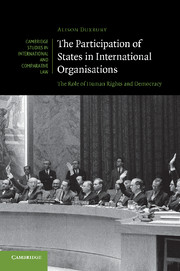Book contents
- Frontmatter
- Contents
- Foreword
- Acknowledgements
- Table of cases
- Table of treaties
- List of abbreviations
- Introduction
- 1 The move to institutions in the age of rights
- 2 The challenge of universality – the League of Nations and the United Nations
- 3 Rights, regionalism and participation in Europe
- 4 Restricting the ranks – excluding states from closed organisations
- 5 The relationship between powers, purposes and participation in specialised organisations
- 6 Legitimacy, democracy and membership
- Conclusion
- Select bibliography
- Index
- CAMBRIDGE STUDIES IN INTERNATIONAL AND COMPARATIVE LAW
- References
3 - Rights, regionalism and participation in Europe
Published online by Cambridge University Press: 01 March 2011
- Frontmatter
- Contents
- Foreword
- Acknowledgements
- Table of cases
- Table of treaties
- List of abbreviations
- Introduction
- 1 The move to institutions in the age of rights
- 2 The challenge of universality – the League of Nations and the United Nations
- 3 Rights, regionalism and participation in Europe
- 4 Restricting the ranks – excluding states from closed organisations
- 5 The relationship between powers, purposes and participation in specialised organisations
- 6 Legitimacy, democracy and membership
- Conclusion
- Select bibliography
- Index
- CAMBRIDGE STUDIES IN INTERNATIONAL AND COMPARATIVE LAW
- References
Summary
Introduction
The year 2004 heralded both a beginning and an end to the process of European integration. For many Central and Eastern European applicant states, 2004 marked the final stage in the lengthy procedures for entry into two regional organisations – the EU and NATO. In the same year, both Croatia and Turkey moved closer to their goal of joining (or rejoining) Europe with the European Council's decision to commence accession negotiations for admission to the EU. The decision to admit ten new members to the EU on 1 May 2004 was welcomed as part of an historic process of reunification – a ‘transformation’ that has changed Europe ‘in a thousand ways, and for the better’. The celebrations on May Day closely followed the entry of seven countries to NATO in March 2004 and a string of new members to the Council of Europe in the 1990s. In each case the expansion of these organisations was preceded by an extensive admission procedure involving the fulfilment of a number of conditions on the part of successful applicant states.
The examination of the admission and exclusion practice of the League of Nations and the UN demonstrated that human rights and democracy criteria have played a haphazard role in determining membership of the universal peace organisations. Peace was to be achieved through universality rather than democracy.
- Type
- Chapter
- Information
- The Participation of States in International OrganisationsThe Role of Human Rights and Democracy, pp. 124 - 164Publisher: Cambridge University PressPrint publication year: 2011



